- Topics
- Campaigning
- Careers
- Colleges
- Community
- Education and training
- Environment
- Equality
- Federation
- General secretary message
- Government
- Health and safety
- History
- Industrial
- International
- Law
- Members at work
- Nautilus news
- Nautilus partnerships
- Netherlands
- Open days
- Opinion
- Organising
- Podcasts from Nautilus
- Sponsored content
- Switzerland
- Technology
- Ukraine
- United Kingdom
- Welfare
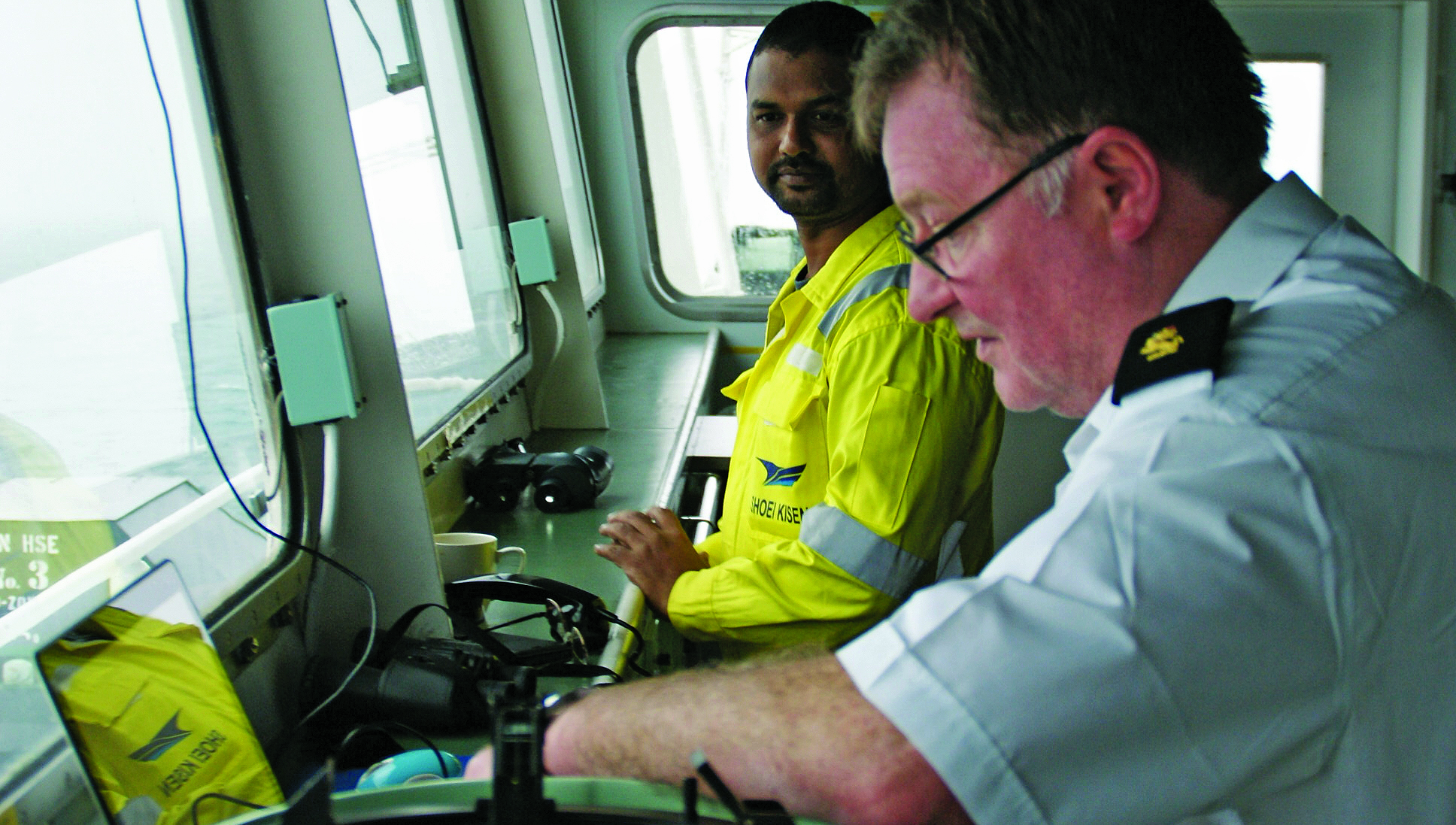
We've all heard of deepsea pilots, but with many operators declining to pay for their services, we may not have encountered one in person. Andrew Linington finds out exactly what they do – and why they should be hired – on a car carrier trip with a Nautilus member
If, as it's often said, the British seafarer is an endangered marine species, Nautilus member Captain Paul Lanaghan is an extremely rare breed.
For Capt Lanaghan is one of fewer than 100 deepsea pilots working in the UK and NW Europe, providing expert advice and assistance to hard-pressed crews of ships in some of the world’s most congested and challenging waters.
Today, he's starting what is set to be a two-week rotation onboard the 61,775gt car carrier Cygnus Leader. Boarding the vessel in the port of Bristol, he's helping the Indian master and navigating officers through the increasing number of Channel 'hotspots' in some typically testing autumnal conditions.
Carriage of a deepsea pilot has, since 1981, been recommended by the International Maritime Organization (IMO) on ships transiting the North Sea, English Channel and Skagerrak. However, it's estimated that barely 2.5% of the 80,000 vessels than run through the Dover Straits each year utilise the pilots' services.
'The truth is, there are many owners and seafarers who don’t even know the service exists – and then there is the challenge of convincing them of its value when the commercial aspects do not jump out first and foremost,' says Chris Brooks, from Gravesend-based Deep Sea & Coastal Pilots (DSCP), which has been running since 1947 and is one of the largest agencies in Europe.
Capt Lanaghan – who is one of some 30 Trinity House-licenced pilots working through DSCP – says there are strong economic arguments in their favour. 'We can more than pay for ourselves, as we can prevent or minimise delays to the vessel through prudent and economical routeing,’ he notes. ‘On a typical voyage we can cut up to 12 hours of sailing time, saving time and bunker fuel costs.'
Indeed, the presence of a deepsea pilot can reduce the costs of a voyage in the area by as much as US$13,000 – but it's the safety case that should stand out, he stresses. 'In much of this area, masters are having to deal with long and intense periods of navigation with the very strong possibility of adverse weather in complicated traffic situations.
'Then you add into the mix the density of the traffic, fishing vessels and pleasure craft, traffic separation schemes and crossing traffic, tides and currents, sandbanks and sandwaves, windfarms and migrant boats, and if you don’t know the area you can very quickly run into trouble.'
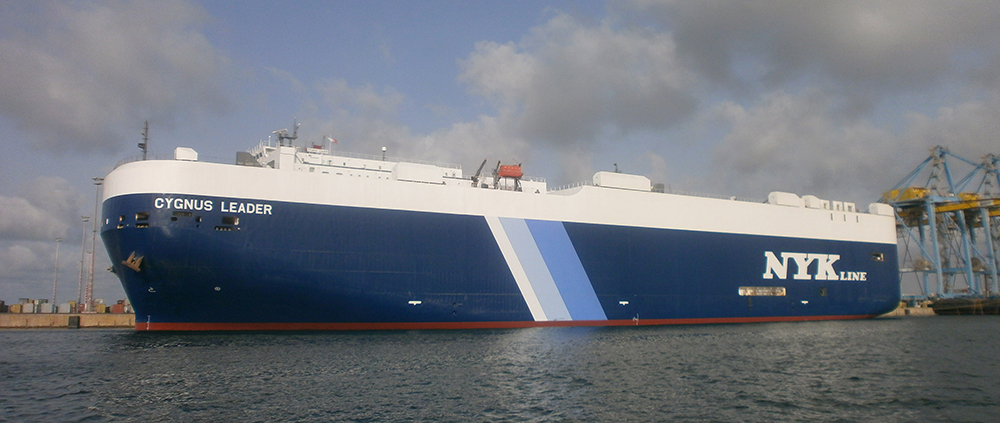
Sometimes you can sense a sigh of relief as soon as you arrive Captain Paul Lanaghan - deepsea pilot
The Channel and the North Sea aren't very old in geological terms, Capt Lanaghan points out, and seafarers need to be very aware of factors like squat when they pass through the very variable depths in the area. 'Meteorological phenomena like low pressures can delay the tide and reduce the height,' he adds. 'This is a place where you can’t relax and always need to be very aware and alert.
'There are also long periods of river pilotage in many European ports – sometimes upwards of six hours – and we can really help to relieve the resulting stress and fatigue faced by masters and officers,' Capt Lanaghan says.
'For a master who is unfamiliar with this area, it can be a daunting task and when combined with any bad weather, reporting procedures, paperwork, port pilotage, cargo and port paperwork commitments, it is easy to see how fatigue can set in and working hour limits potentially breached,' Mr Brooks adds.
'We're familiar with all the various port requirements and pre-arrival paperwork,' Capt Lanaghan says, 'and we can therefore make sure that all the pre-arrival information and communications are correctly dealt with – or advise the master, for instance, that it might be an idea to have a tug to help push them alongside in a port like Zeebrugge during adverse weather.'
In the week before he joins a ship, Capt Lanaghan will research the vessel and the route – noting the potential problem areas along the way and looking at the likely weather conditions. 'You start to build up a layered picture, so you know what to expect,' he explains. 'You always need to have a good, viable, Plan B.'
On this voyage, Capt Lanaghan joined Cygnus Leader in port – but he often boards ships from a launch off Brixham or Cherbourg. Once on the vessel, he will carry out a master-pilot exchange of around 20 minutes and get a feel for the ship and its crew.
'Sometimes you can sense a sigh of relief as soon as you arrive,' he explains. 'You are often on a ship for a reasonable period of time and can establish a decent working relationship and build a good level of teamwork.
'I’ll talk through decisions with the watchkeeping officer and will tell them they are in charge, that I'm here to help them and that they should immediately say if I am doing anything they don't like,' he adds. 'Some cultures don't like to challenge you, but it's all about breaking down these barriers to get effective bridge management.'
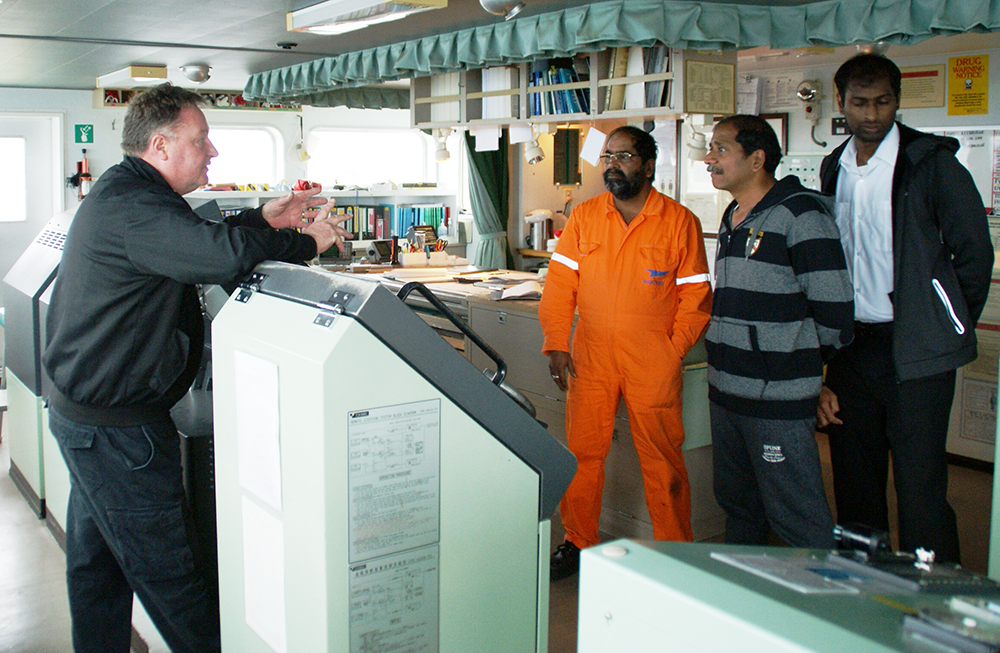
The master and officers onboard Cygnus Leader tell me how much they appreciate Paul's presence – in particular in helping to ease the stresses of paperwork and intense concentration while visiting so many ports in such a short space of time. 'I am very pleased to have a deepsea pilot onboard,' says Captain Subra Arumugam. 'Knowing there is someone with so much knowledge and experience of the area makes us all feel more comfortable and takes a lot of pressure off everyone.'
Capt Lanaghanl points out that he clearly can't be continuously on the bridge during most of his pilotage trips and he does not like to go much beyond six hours at a time. But in preparing for the voyage he identifies the most challenging points – in this case, going around Land’s End, entering the TSS, and approaching the Casquets and the Wandelaar – and will go the wheelhouse well before the ship reaches them. He's also available at any time if the bridge team need his help, and will handle much of the communication with VTS and coastguards, which is invaluable for seafarers with limited English language skills.
'You have to adapt to the environment onboard each ship, and it can be tiring and stressful at times,' he admits. 'You learn from experience when you need to be up, and the decision is primarily based on traffic choke points and reporting requirements, and where the fishing boats, ferries and local traffic will be.
'You are thinking ahead all the time,' Capt Lanaghan adds. 'But you also need to watch out behind you – it's like a game of 3D chess, as you are trying to maintain a proactive picture of what's happening around you. At the same time, you are trying to pull lots of moving parts together – rules of the road, complex traffic situations, weather, and schedules. It can be very challenging and it's not for the faint-hearted, but I enjoy a challenge and being tested so I can draw on my skills and experience.'
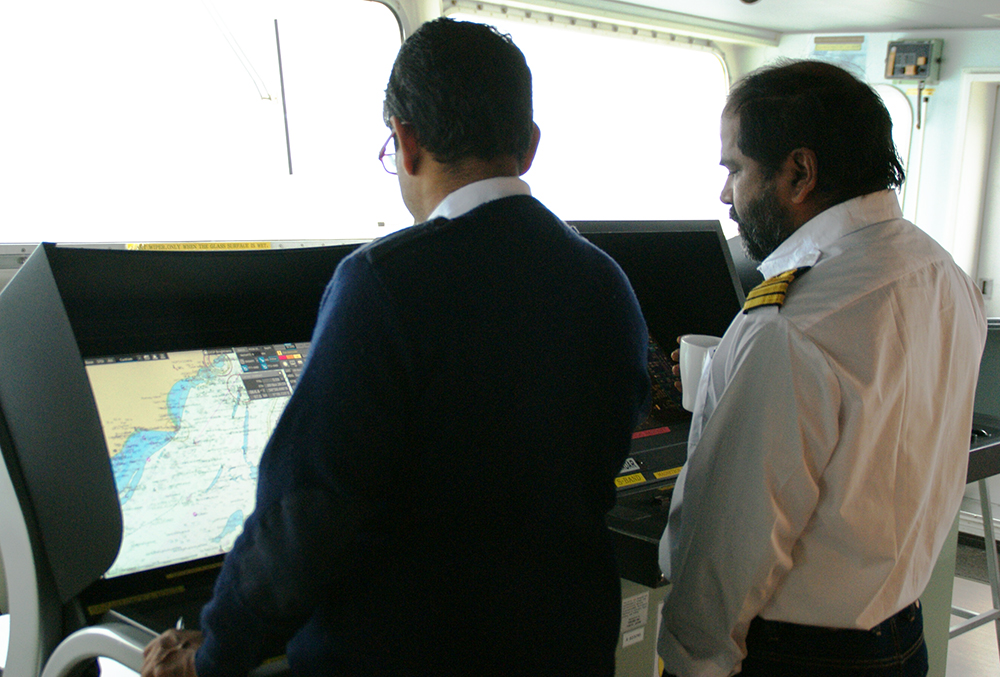
DSCP only uses pilots who have been certified by Trinity House, and it requires a minimum of three years of command experience from candidates holding a current Class 1 master's certificate and experience of sailing in Europe. Once selected, they will undertake a number of training trips with senior pilots before a final training voyage conducting the pilotage under the supervision and assessment of a licensed pilot. If all that goes well, candidates will then take a two-hour oral examination at Trinity House before being awarded their licence.
Capt Lanaghan been a deepsea pilot since 2016, coming to the job with almost 40 years of seagoing experience behind him. 'In the North East, traditionally, you either went down the mines or into industry,' he says. 'I didn't fancy going down the mines and in South Shields there were two people you aspired to be – a Tyne pilot or a ship's captain.'
Capt Lanaghan joined Bank Line as a 17-year-old cadet. 'I thought that going to sea would be a romantic lifestyle, seeing all these far-off places,' he recalls. 'I had a ball for the first two years on the South Pacific trade, starting off in Tahiti and working through all the islands before returning to the UK six months later.'
Early in his career, he was on a ship that rescued nearly 300 refugees in the South China Sea – some of whom he is still in touch with. He also served in the Falklands conflict on the Bank Line vessel Cedarbank, shortly before the company sold its ships, and went on to work for Jardine Matheson.
Joining the Saudi tanker company Vela in 1994, Capt Lanaghan gained his first command at the age of 37 and served on vessels of up to 420m and 428,000dwt before going on to work for Chevron as a mooring master in west Africa and freelance operations in Mozambique and Uruguay.
'I didn't care for a job in the office and a friend at Trinity House in Newcastle who was a deepsea pilot suggested I should give it a try,' he says. 'Because of my time coming from the Middle East to Rotterdam on Vela ships, I had gained a good familiarity with the geographical area.'
Capt Lanaghan's licence – which covers an area stretching from Gibraltar to Archangel, Russia, up to the entrance to the Skagerrak, and to 14 degrees west – has to be renewed every year. There is a revalidation interview and Trinity House checks on his charts, paperwork and nautical publications. 'It's like a law degree,' he says. 'Things are constantly changing, and you need to keep up to speed with all the changes to North Sea buoyage, navigation lanes and reporting procedures.'
Each deepsea pilot carries their own ARCS charts, corrected and up to date, as well as relevant nautical publications in an electronic format. They can use the pilot plug linkage to the vessel's AIS and an independent GPS to give their own real-time display of the ship's track and surrounding conditions.
DSCP trains its pilots on a variety of vessel types and they can be called upon to sail on anything from car carriers to containerships, bulk carriers and tankers, gas carriers and occasional passengerships, and even US Seallift Command vessels.
The role of the deepsea pilot can also extend to navigational safety audits and bridge resource management training, carrying out sea traffic services onboard seismic survey vessels or assisting with rig moves.
Capt Lanaghan says he enjoys the variety and doesn’t have a favourite vessel type to serve on. 'Because of my past experience, going on to a VLCC is like putting on a pair of old slippers,' he admits. 'But every ship has its own specific characteristics and challenges, and now that many containerships have become behemoths it is like being on a VLCC.'
Most deepsea pilots will typically do around 20 rotations a year and the nature of these varies from vessel to vessel. A VLCC may simply require a passage from Brixham to Rotterdam, while a car carrier visiting as many as eight or nine ports within 15 or 16 days in NW European waters may need a deepsea pilot onboard the whole time.
Although the practice of deepsea pilotage can be traced back to the 16th century, its modern form owes much to the period after the Second World War when expert local knowledge was required to navigate ships through a handful of narrow swept routes past minefields which had been laid in the North Sea. Originally intended as a temporary measure, the service expanded as operators recognised its safety and economic benefits.

Capt Lanaghan argues that the need for deepsea pilotage services has never been greater than today. 'It's not just the amount of traffic out there, but also because of things like the huge increase in windfarms and offshore developments which have restricted navigational areas in the southern North Sea and the Channel,' he points out.
'The boom in windfarm traffic has created a lot of additional traffic and the scale of some of the sites means that some of the shortcuts that we used to use in the North Sea have been lost,' he explains. 'This is only going to get worse, and in some parts of the southern North Sea we stand to lose up to two-thirds of the sea area because of the projected windfarm developments.'
Traffic separation schemes have done much to improve safety in the area, he notes, but they do have the effect of funnelling vessels into concentrated areas and hubs.
'This is exacerbated by what we call "red line fever" with a lot of conduct dictated by ECDIS and AIS, and lots of ships going for the same point on the chart and being reluctant to use the full width of the lane,' Capt Lanaghan says. 'Red line fever combined with stupidity and ignorance is not a good combination.'
As a perfect illustration of his point, Capt Lanaghan makes good use of the available space to pass a group of ships bunched up on the same track towards the Sandettie light vessel and to put Cygnus Leader into a good position for the approach to Wandelaar, where a local pilot will come aboard.
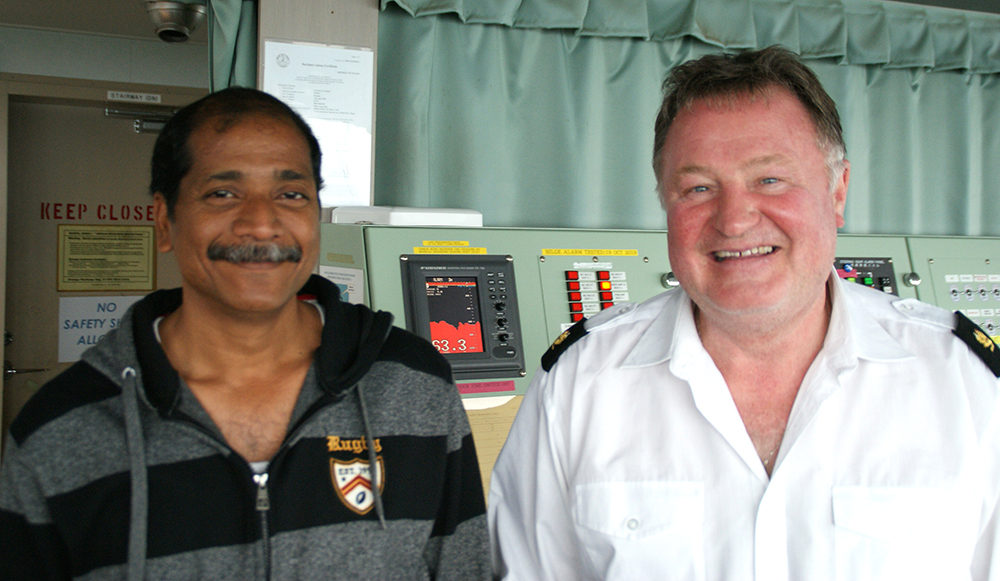
On an average day there are around 400 vessel movements in the Channel. Looking today at the significantly reduced visibility outside and at the almost convoy-like patterns of ships on the radar, as well as the numbers seeking to cross lanes or radiate off onto different routes after passing waypoints, it's not hard to appreciate the scale of the challenge facing navigators unfamiliar with these waters.
Capt Lanaghan – who recently used his experience to contribute to the new edition of Witherby Seamanship's Passage Planning Guide to the English Channel, Dover Strait and Southern North Sea – says he also sees an increasing new challenge being posed by the growing size and reduced manoeuvrability of many ships at a time when environmental pressure is curbing their power.
Deepsea pilotage isn't confined to the Channel and the North Sea – it's in use in the Baltic Sea, the Malacca Straits and the Bosporus Straits, as well as being mandatory for vessels transiting the Great Barrier Reef and Torres Strait in Australia.
The use of a deepsea pilot in the North Sea, Channel and Skagerrak is 'recommended' by the IMO. But companies like NYK who regularly use their services are in a very small minority.
Pressure for compulsory carriage was stepped up in 2002, when the car carrier Tricolor sank in the Channel following a collision with a containership. The wreck was struck by two other ships in the next fortnight, despite the presence of guard vessels, navigational warnings, and buoys and Racon transponders.
However, international shipowners rejected moves to beef up the IMO recommendation, arguing that 'no compelling need' had been established for stricter requirements and that 'the function and perceived benefit' of carrying a deepsea pilot in adverse conditions was unclear. 'The pilot cannot be a member of the ship’s crew and his or her presence will not relieve the master of the responsibility for safe navigation,' the owners argued.
Mr Brooks says he find such resistance 'quite staggering' and a reflection of the way the industry often tends to take a reactive rather than proactive approach to safety. Nevertheless, he adds, the last few years have seen growth in demand, much of it fuelled by the tanker sector. 'There is a lot more focus on charterers taking deepsea pilots now, and especially if a master has not transited the area in the last six months,' he says.
Capt Lanaghan says he loves the job and would recommend it as a career choice for fellow seafarers. But he worries about where the next generation will come from. 'I'm passionate about training and education and it's sad to see the big reduction in cadet numbers since I came to sea. I think demand for our services will increase because of the growing complexities of navigation in this area, but it will be a struggle to find the people to follow in our footsteps. We've already got many deepsea pilots who are approaching the end of their careers, and the demographics of the industry are not good. Something has got to give soon.'
Tags
